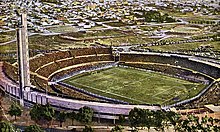Estadio Centenario (Montevideo)
| Estadio Centenario | |
|---|---|

|
|
| The Estadio Centenario in Montevideo (2006) | |
| Data | |
| place |
|
| Coordinates | 34 ° 53 '40.4 " S , 56 ° 9' 8.1" W |
| owner | City of Montevideo |
| start of building | July 21, 1929 |
| opening | July 18, 1930 |
| First game | July 18, 1930 Uruguay 1-0 Peru |
| surface | Natural grass |
| architect | Juan Antonio Scasso |
| capacity | 60,235 seats |
| Societies) | |
| Events | |
The Estadio Centenario is the largest football stadium in the Uruguayan capital, Montevideo . Among other things, it was the venue for the 1930 World Cup . The original capacity of around 100,000 spectators had to be reduced to 60,235 seats for safety reasons.
history
The Centenario is located on Avenida Américo Ricaldoni and Avenida Federico Vidiella in the Barrio Parque Batlle . It is used by the Uruguayan national team as well as the clubs Nacional Montevideo and Peñarol Montevideo . The stadium's name was chosen because of the 100th anniversary of Uruguay's independence. It was opened on July 18, 1930 with the World Cup game Uruguay against Peru (1-0), exactly 100 years after the constitutional oath, the adoption of the first constitution as part of Uruguay's independence ( Jura de la Constitución ).
The stadium was designed by the architect Juan Antonio Scasso . Construction began on July 21, 1929. It was completed in the record time of six months. Architecturally, it can be assigned to the modern age ( arquitectura moderna ) and is considered to be the first stadium in the world that is fitted into its natural surroundings and is thus described as unique. Architect Juan Antonio Scasso designed it in such a way that the playing field was lowered below the surface of the terrain. With the Torre de los Homenajes , however, part of the construction is visible from afar. The stadium is divided into four areas, the Tribunas Olimpica, Colombes , America and Amsterdam . The names of the tribunas are reminiscent of the locations of the greatest successes of the Uruguayan national football team.
The stadium has hosted the Campeonato Sudamericano and Copa America (1942, 1956, 1967, 1995) four times , and each year Uruguay has won the South American championship without losing a single game in the Centenario. Even Brazil have only won two out of 20 games in this stadium so far. In the final of the football World Cup in 1930 , Uruguay beat Argentina 4-2 and thus secured the title of first football world champion . The German national soccer team , on the other hand, has a flawless record against Uruguay in the Centenario in their two previous appearances. On June 8, 1977 the German team won 2-0 and on December 20, 1992 4-1. However, Germany lost its two games here at Mundialito 1980/81 (1: 2 against Argentina and 1: 4 against Brazil). In addition to football matches, concerts are also held in the stadium.
The Estadio Centenario was declared on July 18, 1983 by FIFA as the only world football monument ( Monumento Histórico del Fútbol Mundial ) to date . On the ground floor of the Torre de los Homenajes there is a football museum with u. a. Exhibits related to the 1930 and 1950 World Cup , the 1924 Olympic Football Tournament and the 1928 Olympic Football Tournament , in which Uruguay came out on top. The Estadio Centenario has been classified as a Bien de Interés Municipal since 1995 .
Grandstands
The Centenario currently offers a total of 60,235 seats on its four grandstands.
- Tribuna América: 10,750 seats, main stand, west
- Tribuna Olímpica: 21,648 seats, opposite stand, east
- Tribuna Amsterdam: 13,923 seats, back gate, south
- Tribuna Colombes: 13,914 seats, back gate, north
gallery
Panoramas
See also
literature
- Guía Arquitectónica y Urbanística de Montevideo. 3. Edition. Intendencia Municipal de Montevideo et al., Montevideo et al. 2008, ISBN 978-9974-600-26-3 , pp. 101, 167.
Web links
- estadiocentenario.com.uy: Stadium website (Spanish)
- de.fifa.com: dates and history
- stadionwelt.de: Detailed picture gallery
- worldstadiums.com: Architecture of the stadium (English)
- gigapan.com: Gigapan image of the stadium (English)
Individual evidence
- ^ Ficha: Estadio Centenario (Spanish), accessed on July 8, 2012
- ↑ setlist.fm: concert list of the Estadio Centenario (English)
- ↑ estadiocentenario.com.uy: History of the stadium (Spanish)
- ↑ Information about Montevideo at goethe.de
- ↑ estadiocentenario.com.uy: Stadium capacity accessed on January 18, 2015 (Spanish)






